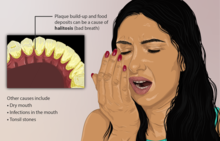
Back بخر Arabic Галітоз Byelorussian Галітоз BE-X-OLD নিঃশ্বাসে দুর্গন্ধ Bengali/Bangla Halitosi Catalan بۆنی ناودەم CKB Zápach z úst Czech Mundgeruch German Κακοσμία του στόματος Greek Halitosis Spanish
| Bad breath | |
|---|---|
| Other names | Halitosis, fetor oris, oral malodour, putrid breath |
 | |
| Specialty | Gastroenterology, otorhinolaryngology, dentistry |
| Symptoms | Unpleasant smell present on breath[1] |
| Complications | Anxiety, depression, obsessive compulsive disorder[1] |
| Types | Genuine, non-genuine[2] |
| Causes | Usually from inside the mouth[1] |
| Treatment | Depends on cause, tongue cleaning, mouthwash, flossing[1] |
| Medication | Mouthwash containing chlorhexidine or cetylpyridinium chloride[1] |
| Frequency | ~30% of people[1] |
Bad breath, also known as halitosis, is a symptom in which a noticeably unpleasant breath odour is present.[1] It can result in anxiety among those affected.[1] It is also associated with depression and symptoms of obsessive compulsive disorder.[1]
The concerns of bad breath may be divided into genuine and non-genuine cases.[2] Of those who have genuine bad breath, about 85% of cases come from inside the mouth.[1] The remaining cases are believed to be due to disorders in the nose, sinuses, throat, lungs, esophagus, or stomach.[3] Rarely, bad breath can be due to an underlying medical condition such as liver failure or ketoacidosis.[2] Non-genuine cases occur when someone complains of having bad breath but other people cannot detect it.[2] This is estimated to make up between 5% and 72% of cases.[2]
The treatment depends on the underlying cause.[1] Initial efforts may include tongue cleaning, mouthwash, and flossing.[1] Tentative evidence supports the use of mouthwash containing chlorhexidine or cetylpyridinium chloride.[1] While there is tentative evidence of benefit from the use of a tongue cleaner it is insufficient to draw clear conclusions.[4] Treating underlying disease such as gum disease, tooth decay, tonsil stones, or gastroesophageal reflux disease may help.[1] Counselling may be useful in those who falsely believe that they have bad breath.[1]
Estimated rates of bad breath vary from 6% to 50% of the population.[1] Concern about bad breath is the third most common reason people seek dental care, after tooth decay and gum disease.[2][3] It is believed to become more common as people age.[1] Bad breath is viewed as a social taboo and those affected may be stigmatized.[1][2] People in the United States spend more than $1 billion per year on mouthwash to treat it.[3]
- ^ a b c d e f g h i j k l m n o p q r Kapoor, U; Sharma, G; Juneja, M; Nagpal, A (2016). "Halitosis: Current concepts on etiology, diagnosis and management". European Journal of Dentistry. 10 (2): 292–300. doi:10.4103/1305-7456.178294. PMC 4813452. PMID 27095913.
- ^ a b c d e f g Harvey-Woodworth, CN (April 2013). "Dimethylsulphidemia: the significance of dimethyl sulphide in extra-oral, blood borne halitosis". British Dental Journal. 214 (7): E20. doi:10.1038/sj.bdj.2013.329. PMID 23579164.
- ^ a b c Loesche, WJ; Kazor, C (2002). "Microbiology and treatment of halitosis". Periodontology 2000. 28: 256–79. doi:10.1034/j.1600-0757.2002.280111.x. PMID 12013345.
- ^ Van der Sleen, Mi; Slot, De; Van Trijffel, E; Winkel, Eg; Van der Weijden, Ga (2010-11-01). "Effectiveness of mechanical tongue cleaning on breath odour and tongue coating: a systematic review". International Journal of Dental Hygiene. 8 (4): 258–268. doi:10.1111/j.1601-5037.2010.00479.x. ISSN 1601-5037. PMID 20961381.